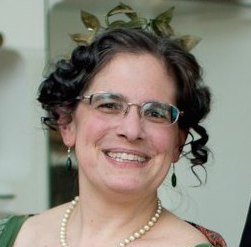Double Quadrille is a cotillion (dance party game) figure from H. Layton Walker’s Twentieth Century Cotillion Figures (Two Step Publishing Company, Buffalo, New York, 1912), though the “game” element is extremely limited. The original setup is not even a standard cotillion opening with couples dancing and then separating to find new partners; instead, each couple seeks another couple.
The language and timing of the figure are ambiguous, and I’ve found no other source to clarify things. So I’ve had to make some guesses and minor tweaks in order to create something that actually works.
Here’s the original language from Walker:
DOUBLE QUADRILLE.
Four couples perform a tour de valse. Each couple selects another couple and they form a double quadrille; the head couples right and left; half sides the same. Ladies chain; all the ladies forward four steps, turn and face partners; gentlemen take the right hand of partners and left hand of lady on their left; all balance; the ladies facing outward, gentlemen inward; turn partners to places. The figure is danced over to regain places. Signal for all to waltz to places.
The opening is straightforward: four couples dance. Waltz is given, but there’s no reason it wouldn’t work in two-step as well. At the signal, the four couples each seek another couple, and they all form a double quadrille set in the form of a large square, two couples on each side. Notice that despite Walker’s tendency to borrow figures from older manuals, this is not the same as the Double Quadrille (figure #73) from Allen Dodworth’s Dancing and its relations to education and social life (first edition, 1885; later editions to 1913). The Double Quadrille published by Dodworth formed its quadrille in cross formation rather than in a large square.
The beginning is the last thing that is straightforward, alas. The problems start with the very first figure:
the head couples right and left; half sides the same.
I cannot come up with any logical interpretation for “half sides”, but since the instructions specify that the figure has to be repeated to “regain places”, I am guessing this is a punctuation error, and the figure ought to be “the head couples right and left half; sides the same”. That would take eight bars (four bars for heads, four for sides) and leave all the couples across the set from where they started.
The next problem is one of timing:
Ladies chain; all the ladies forward four steps, turn and face partners; gentlemen take the right hand of partners and left hand of lady on their left; all balance; the ladies facing outward, gentlemen inward; turn partners to places.
Working backwards, the final balance and turn partners ought to be eight bars. The ladies chain is presumably either eight or sixteen bars, depending on whether it is half only (matching the first figure) or complete. That leaves an awkward third section: the ladies go forward four steps (two bars). The gentlemen step up to take their hands in…six bars? That’s far too much time. Two bars would make more sense, but that leaves a four-bar figure in the middle of all the eight- or sixteen-bar figures, which is musically messy. Cramming the entire thing plus the balance into four bars (meaning the balance is more-or-less incorporated into the gentlemen taking the ladies’ hands) is too rushed and leaves a twenty-four-bar figure, which is less than ideal musically.
My best-guess solution is to stretch things out, using the same trick I did in the Kentucky Reel of taking hands sequentially: the ladies go forward (four steps) continue forward turning around (four steps), then the gentlemen go forward (four steps) and take first right hands (two beats) then left (two beats). That’s a total of sixteen steps or beats, eight bars. Make the ladies chain only a half-chain, and everything adds up to a nice thirty-two-bar figure:
8b Heads half right and left; sides half right and left
8b Heads half ladies chain; sides half ladies chain
8b Ladies forward (2b) and turn to face partners (2b); gents forward (2b) and take right hand with partner (1b) and left with neighbor lady (1b) forming a “wavy circle”
8b All balance (4b) and turn partner by right hands to places (4b)
I’m interpreting the gentleman’s “partner” in the second half as “the lady who is temporarily dancing in his partner’s place”.
After the first sixteen bars, the gentlemen are in the opposite places from where they began the dance and the ladies are in their original places, but with their opposite gentlemen, which fulfills the requirement that the figure must be repeated to get everyone to original places. The half ladies chain also creates a slight mixer element.
Note that after the final turn to places the first time through, the head couples need to drop hands and quickly reorient themselves to restart the figure with the half right and left again. The second time, everyone can simply slide into closed position at the end of the turn for the final waltz-around (or two-step-around).
Assuming there are more than eight couples at one’s ball or cotillion party, the figure would then be repeated with another set of four couples leading. For a really large group, one could cheat a little and have more than one set each time to speed things up.


Leave a Reply